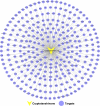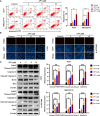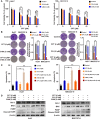Uncovering the Mechanisms of Cryptotanshinone as a Therapeutic Agent Against Hepatocellular Carcinoma
- PMID: 32903546
- PMCID: PMC7438559
- DOI: 10.3389/fphar.2020.01264
Uncovering the Mechanisms of Cryptotanshinone as a Therapeutic Agent Against Hepatocellular Carcinoma
Abstract
Hepatocellular carcinoma (HCC) is a fatal and dominant form of liver cancer that currently has no effective treatment or positive prognosis. In this study, we explored the antitumor effects of cryptotanshinone (CPT) against HCC and the molecular mechanisms underlying these effects using a systems pharmacology and experimental validation approach. First, we identified a total of 296 CPT targets, 239 of which were also HCC-related targets. We elucidated the mechanisms by which CPT affects HCC through multiple network analysis, including CPT-target network analysis, protein-protein interaction network analysis, target-function network analysis, and pathway enrichment analysis. In addition, we found that CPT induced apoptosis in Huh7 and MHCC97-H ells due to increased levels of cleaved PARP, Bax, and cleaved caspase-3 and decreased Bcl-2 expression. CPT also induced autophagy in HCC cells by increasing LC3-II conversion and the expression of Beclin1 and ATG5, while decreasing the expression of p62/SQSTM1. Autophagy inhibitors (3-methyladenine and chloroquine) enhanced CPT-induced proliferation and apoptosis, suggesting that CPT-induced autophagy may protect HCC cells against cell death. Furthermore, CPT was found to inhibit the phosphatidylinositol 3-kinase (PI3K)/protein kinase B (Akt)/mammalian target of rapamycin (mTOR) signaling pathway. Interestingly, activation of PI3K by insulin-like growth factor-I inhibited CPT-induced apoptosis and autophagy, suggesting that the PI3K/AKT/mTOR signaling pathway is involved in both CPT-induced apoptosis and autophagy. Finally, CPT was found to inhibit the growth of Huh7 xenograft tumors. In conclusion, we first demonstrated the antitumor effects of CPT in Huh7 and MHCC97-H cells, both in vitro and in vivo. We elucidated the potential antitumor mechanism of CPT, which involved inducing apoptosis and autophagy by inhibiting the PI3K/Akt/mTOR signaling pathway. Our findings may provide valuable insights into the clinical application of CPT, serving as a potential candidate therapeutic agent for HCC treatment.
Keywords: apoptosis; autophagy; cryptotanshinone; hepatocellular carcinoma; system pharmacology.
Copyright © 2020 Luo, Song, Wang, Huang, Liu, Wang, Hong and Yuan.
Figures












Similar articles
-
Arenobufagin, a natural bufadienolide from toad venom, induces apoptosis and autophagy in human hepatocellular carcinoma cells through inhibition of PI3K/Akt/mTOR pathway.Carcinogenesis. 2013 Jun;34(6):1331-42. doi: 10.1093/carcin/bgt060. Epub 2013 Feb 7. Carcinogenesis. 2013. PMID: 23393227
-
Dual PI3K/mTOR inhibitor NVP-BEZ235-induced apoptosis of hepatocellular carcinoma cell lines is enhanced by inhibitors of autophagy.Int J Mol Med. 2013 Jun;31(6):1449-56. doi: 10.3892/ijmm.2013.1351. Epub 2013 Apr 16. Int J Mol Med. 2013. PMID: 23588698
-
Hugan Buzure Induces Autophagy and Apoptosis in Hepatocellular Carcinoma by Inhibiting PI3K/Akt/mTOR Signaling Pathway.Evid Based Complement Alternat Med. 2022 Dec 19;2022:1618491. doi: 10.1155/2022/1618491. eCollection 2022. Evid Based Complement Alternat Med. 2022. PMID: 38094222 Free PMC article.
-
Targeting the PI3K/Akt/mTOR Pathway in Hepatocellular Carcinoma.Biomedicines. 2021 Nov 8;9(11):1639. doi: 10.3390/biomedicines9111639. Biomedicines. 2021. PMID: 34829868 Free PMC article. Review.
-
The Role of Autophagy in Liver Cancer: Crosstalk in Signaling Pathways and Potential Therapeutic Targets.Pharmaceuticals (Basel). 2020 Nov 28;13(12):432. doi: 10.3390/ph13120432. Pharmaceuticals (Basel). 2020. PMID: 33260729 Free PMC article. Review.
Cited by
-
Systems Pharmacology-Based Strategy to Investigate the Mechanism of Ruangan Lidan Decoction for Treatment of Hepatocellular Carcinoma.Comput Math Methods Med. 2022 Dec 17;2022:2940654. doi: 10.1155/2022/2940654. eCollection 2022. Comput Math Methods Med. 2022. PMID: 36578460 Free PMC article.
-
Pharmacokinetics and tissue distribution of bleomycin-induced idiopathic pulmonary fibrosis rats treated with cryptotanshinone.Front Pharmacol. 2023 Mar 9;14:1127219. doi: 10.3389/fphar.2023.1127219. eCollection 2023. Front Pharmacol. 2023. PMID: 36969870 Free PMC article.
-
Cryptotanshinone Inhibits the Growth of HCT116 Colorectal Cancer Cells Through Endoplasmic Reticulum Stress-Mediated Autophagy.Front Pharmacol. 2021 Jun 17;12:653232. doi: 10.3389/fphar.2021.653232. eCollection 2021. Front Pharmacol. 2021. PMID: 34220498 Free PMC article.
-
Molecular Mechanism of Tanshinone against Prostate Cancer.Molecules. 2022 Aug 30;27(17):5594. doi: 10.3390/molecules27175594. Molecules. 2022. PMID: 36080361 Free PMC article. Review.
-
Recent advances of tanshinone in regulating autophagy for medicinal research.Front Pharmacol. 2023 Jan 12;13:1059360. doi: 10.3389/fphar.2022.1059360. eCollection 2022. Front Pharmacol. 2023. PMID: 36712689 Free PMC article. Review.
References
LinkOut - more resources
Full Text Sources
Research Materials
Miscellaneous

